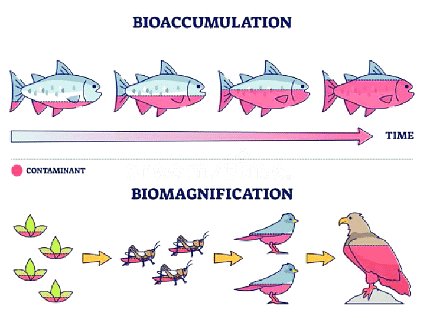Class 8 Exam > Class 8 Notes > Year 8 Biology (Cambridge) > Ecosystems
Ecosystems | Year 8 Biology (Cambridge) - Class 8 PDF Download
Bioaccumulation
- Bioaccumulation refers to the process where organisms absorb and store substances, such as toxins or chemicals, at a rate faster than they can eliminate them.
- This accumulation occurs within individual organisms and can lead to higher concentrations of these substances over time.
Key Points
- Organisms accumulate toxins from their environment through ingestion, absorption, or inhalation.
- Toxins typically include heavy metals like mercury, pesticides, and persistent organic pollutants (POPs).
- Examples include fish accumulating mercury from polluted waters or birds storing pesticides in their bodies.
Examples
- Fish in polluted lakes accumulating mercury from industrial runoff.
- Birds storing DDT pesticides in their tissues from contaminated prey.
Impact on Organisms
- Bioaccumulated toxins can impair immune function, reproductive systems, and overall health.
- They pose risks to predators at higher trophic levels due to increased concentrations.

Biomagnification
- Biomagnification is the process where concentrations of toxins increase progressively up the food chain.
- Predators at higher trophic levels accumulate higher concentrations of toxins than their prey.
Key Points
- Toxins become more concentrated as they move up the food chain.
- Top predators, like eagles or sharks, often suffer the most from biomagnification.
Examples
- DDT becoming more concentrated in fish-eating birds compared to the fish they consume.
- PCBs (polychlorinated biphenyls) increasing in seals that eat fish containing these pollutants.
Food Chains
- A food chain is a linear sequence showing the transfer of energy and nutrients from one organism to another through consumption.

Key Points
- Starts with producers (plants) that convert sunlight into energy through photosynthesis.
- Followed by primary consumers (herbivores) that eat producers.
- Secondary consumers (carnivores) eat primary consumers, and so on.
Examples
- Grass (producer) → Rabbit (primary consumer) → Fox (secondary consumer).
- Phytoplankton (producer) → Zooplankton (primary consumer) → Small fish (secondary consumer).
Question for EcosystemsTry yourself: Which process describes the progressive increase in toxin concentrations up the food chain?View Solution
Human Impact
- Human activities significantly contribute to the introduction of toxins into ecosystems, leading to bioaccumulation and biomagnification.
Key Points
- Industrial pollutants like heavy metals and pesticides enter water bodies and soil.
- These pollutants are ingested by organisms and accumulate within their tissues.
- Consumption of contaminated organisms can lead to human health issues.
Examples
- Mercury from industrial waste contaminating fish in rivers.
- Pesticides sprayed on crops ending up in birds of prey through contaminated rodents.
Conclusion
Understanding bioaccumulation, biomagnification, and food chains is crucial for comprehending ecological impacts and human health risks associated with environmental pollutants. These processes illustrate how toxins move through ecosystems and concentrate in organisms, affecting entire food webs and human populations.
The document Ecosystems | Year 8 Biology (Cambridge) - Class 8 is a part of the Class 8 Course Year 8 Biology (Cambridge).
All you need of Class 8 at this link: Class 8
|
6 videos|13 docs|5 tests
|
FAQs on Ecosystems - Year 8 Biology (Cambridge) - Class 8
| 1. How does bioaccumulation impact organisms in food chains? |  |
Ans. Bioaccumulation occurs when toxic substances accumulate in the tissues of organisms at higher trophic levels in a food chain. This can lead to negative impacts on organisms, such as reduced reproductive success, impaired growth and development, and increased susceptibility to diseases.
| 2. Can bioaccumulation affect humans through the consumption of contaminated food? |  |
Ans. Yes, bioaccumulation can affect humans when they consume contaminated food. Toxic substances that have accumulated in the tissues of organisms lower in the food chain can be transferred to humans when they consume those organisms, leading to potential health risks.
| 3. How do food chains play a role in the process of bioaccumulation? |  |
Ans. Food chains play a crucial role in the process of bioaccumulation as toxic substances move up the food chain and become more concentrated in organisms at higher trophic levels. This can result in significant impacts on the health and well-being of those organisms.
| 4. What are some examples of bioaccumulation in real-world ecosystems? |  |
Ans. Some examples of bioaccumulation in real-world ecosystems include the accumulation of mercury in fish, pesticides in birds of prey, and heavy metals in shellfish. These instances highlight the widespread occurrence and potential dangers of bioaccumulation in various ecosystems.
| 5. How can human activities contribute to the process of bioaccumulation in food chains? |  |
Ans. Human activities such as the use of pesticides, industrial pollution, and improper waste disposal can introduce toxic substances into the environment, which can then be taken up by organisms and accumulate in food chains. This can exacerbate the issue of bioaccumulation and its impacts on ecosystems.
Related Searches
















